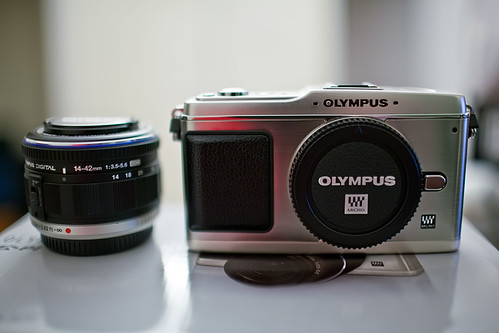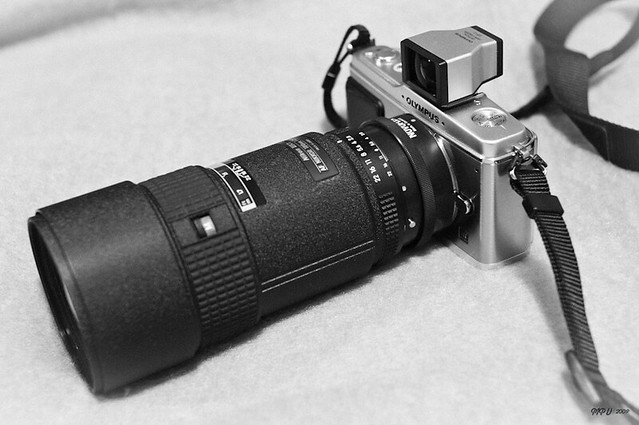Pentax Q, the right camera at the right time?
Earlier this year I've blogged about what I expected of Nikon's mirror-less offering (which still has not been released). At that time I'd expected Canon to also come up with such a camera. I never expected the relatively small company Pentax to come up with a radically different mirror-less camera. But they did and here is my review of the Pentax Q (based on the press release)Mirror-less?
Now, a quick refresher on camera technology. For years we could divide the digital cameras on the market in two categories. Compact cameras which did not have changeable lenses and DSLR cameras which did. In this picture you can see why they call it a single lens reflex.
The light that enters the lens is reflected upwards by a mirror which then goes trough a prism (or a reflective coating on the cheaper models) and reaches the eye of the photographer. It's been a more or less unchanged design for decades. It works, you see what you are going to shoot but the mirror takes up space and the mechanism that moves it out of the way takes up more space. This effectively places limits on how small you can make one of these. Olympus' E-420 and 620 are about as small as you can make of these cameras.
In 2009 Olympus changed all this with the introduction of the E-P1 "Pen". A small camera, no mirror just a screen at the back but it still featured changeable lenses. This allowed them to make a camera that was significantly smaller as you can see in this picture with a 14-42 kit lens on the left.

That lens is the kind of big thing you see in the first drawing.
Because of the interchangeable lens this class of cameras is also called EVIL (Electronic Viewfinder Interchangeable Lens)
Mirrorless in 2011
Fast forward to 2011. Olympus and Samsung have a nice range of cameras and lenses using the M 4/3 mount. Samsung is working on building their NX series and Sony entered the market in a rather massive way with their NEX series of e-mount cameras. A complete list can be found here. From the first, rather clumsy, Olympus we've seen a rapid development. The number of available lenses has progressed nicely. 3rd party manufacturers are also the market and, because these mounts are smaller, there's adapters available to mount all sort of lenses on these cameras.

Of course holding a combination like this, a Pen with a 180mm Nikon, stable at arm's length so you can use the screen will be a challenge.
Pentax enters the market
The last few years Pentax often gave the impression of being an "also-ran" in the highly competitive DSLR market. Good cameras, good lenses, excellent backward compatibility but somehow they seemed not very innovative and easily forgotten.And then, suddenly a press release about a mirrorless camera that was different. From dpreview.com:
To make clear what the rather opaque 1/2.3" figure actually means, it equates to a surface area of around 28mm2. This is around 1/8th the size of the sensor used in Micro Four Thirds cameras and 1/13th the size of the the APS-C format sensor in Sony's NEX. The advantage of this is that the lenses for the Q mount can be made a lot smaller than those for other systems, but the downside is that the image quality is more likely to resemble that of a compact camera than a DSLR.
(source: http://www.dpreview.com/previews/pentaxQ/)
So, a small sensor in a small camera. How small is easily seen in this picture on dpreview:
http://a.img-dpreview.com/previews/pentaxQ/images/sidebyside1.jpg
It's actually small enough to make a Sony NEX look big!
This small sensor and the lack of a real grip (The fat part you see on the Sony) will be sufficient to cause any serious photography writer to dismiss this camera out of hand as being nothing more than a toy. Thom Hogan, a writer and photographer who I deeply respect, has already done so and I suspect many more will follow. He's even compared it to the 110 cassette SLR from late 1970s. For those of you who are too old, it was a SLR camera based on the tiny 110 film cassette. It came out as 110 was already going out of favour. Read more about it here on camerapedia.
Now if we look at the camera (pics courtesy of Pentax' press release)


We do indeed see a tiny camera with a cute lens. From the nice retro leather case to the flash that can pop up a bit on an arm, thought has gone into the deisgn. Let's look at the features.
HD Video
These days everyone has a big HD television in their home and people are looking for cameras that can do HD video. Doesn't matter that the quality comes nowhere near professional quality on most, it needs to do HD because consumers know HD=good. The Q does not disappoint here. 1920x1080 pixels in 30fps. No word yet on the quality, the length of the clips or what autofocus does during recording.Bokeh
Bokeh is a japanese word describing what the out of focus areas of a picture look like. Go to any place where inexperienced photographers meet and sooner or later you see the word leading up to the purchase of a 35 or 50mm f1.8 lens.

Pentax ticks the box. From the press release:
The PENTAX Q comes equipped with newly developed bokeh control function, which allows user to capture the image with obtrusive objects in the field of view optimally defocused. With this function, the camera will automatically judge the focused subject as well as relative distance of each object from the camera in the field of view to apply optimal defocus effect to each object to stand out the main subject(s). This function will allow even a first-time digital photographer to easily capture the images with such effects as background defocus or foreground defocus that otherwise require certain extent of familiarity with the photography.
Now, how this works remains to be seen. It could be some sort of clever software trick, it could simply be a complicated way of saying aperture priority. Pentax gave it some thought and made sure the box is ticked.
Colours
Once again, let's go to that photography novice discussion board. Take a " which camera to buy?" discussion and sooner or later someone will say "I prefer Canon's colours over Nikon's". Every camera manufacturer tweaks jpg output trying to find the balance between accurate and crowd pleasing. On the Q pentax addresses this with these "smart effect modes"
• Brilliant Color: Creates a lively atmosphere by raising the saturation level almost to the point of color saturation.
• Unicolor Bold: Creates an extremely high contrast image that retains one particular color in the image.
• Vintage Color: Produces a toy-camera-like effect, with a choice of several different finishing touches.
• Cross Processing: Produces a unique image with unusual colors, as if treated with the cross processing** used in film photography.
• Warm Fade: Creates a low contrast image with the white balance slightly shifted to pink shades.
• Tone Expansion: Produces a dramatic image with an artistic finishing touch, close to an intensified HDR (High Dynamic Range) effect.
• Bold Monochrome: Produces a low-key, high contrast image with enhanced sh
Effortless Bokeh control
So we see the outlines of the target audience. Check the apple or android market places. There's a ton of apps dedicated to vintage, black and white or cross processing. It's hip!
Other options
Sensor cleaning, check! Image stabilisation, check! Facial recognition, 25 AF points, aspect ratios of 4:3, 3:2, 16:9 or 1:1, 9 shot multiple exposure, all check!
Lenses
Here I see Pentax making a bold move. The camera is sold as a kit with a 47mm f1.9 equivelant lens. That's as close as you can get to the standard 50mm lens that came with any DSLR from the 1960s untill well into the 1980s. It also stops any zoom factor dead in it's tracks, it doesn't have any zoom! Zoom is sold seperately as the 27.5-83mm f2.8-4.5 lens for $299.
What truly impresses me is a $129 fish eye! Fish eyes are hot with a certain crowd. The cheap screw-on lenses are doing well on ebay as are the 8mm f3.5 lenses that are sold under various names (bower, tiffen, samyang) This kind of picture is a must for a certain audience:

Another populair thing is toy cameras. Lomography is hot, Diana toy cameras are sold for insane prices by trendy stores like urban outfitters and the newbie boards are filled with questions like "Do I need lomography film?" and "where can I get 120 film processed and printed?" The craze has gone so far that you can eaven mount toy camera lenses on your Canon or Nikon.
Pentax knows this and they are selling a toy camera wide angle and tele lens for less than $100!
Conclusion
In my opinion this camera has everything to be a big hit with a certain audience if Pentax plays it's cards right. It needs to reach a price point where it can compete with the Sony NEX and the Nikon D3100 and Canon T3. It needs a hip add campaign and perhaps a bit of guerilla marketing as well. If Pentax can do that then they will have a product with a strong appeal to a certain part of the 16-30 demographic. I can picture many teen girls who "just love photography" whining to get one for christmas.Links
Press release on Pentax UKDPReview's preview
Pentax USA
No comments:
Post a Comment